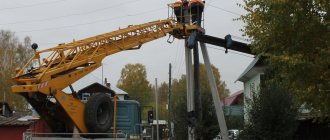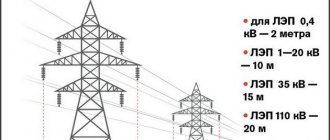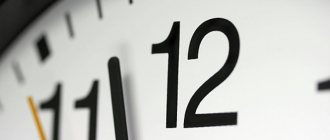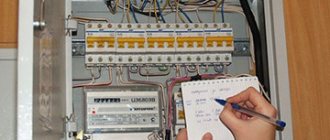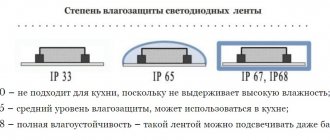Electricity is a type of utility service that you cannot do without, but it is also quite difficult to pay for it.
In addition to various energy saving techniques, there is another alternative way to save electricity - install a special meter and use a night tariff.
By using basic electrical appliances at night, you can significantly reduce your utility bills.
Night electricity tariff: what time does it start and when does it end? What else do you need to know and how to manage your time? The answers to these questions are in our article.
What types of counters are there?
An electric meter is a device that keeps track of how much electricity you use. How much electricity he burned is how much he will show on the display in kilowatt-hours. Then for these kilowatt-hours you will need to pay the energy supply organization at your tariff.
Tariffs vary. Firstly, they depend on the region. For example, in Moscow you will have to pay 4.87 R per kilowatt-hour for a single-tariff meter, and in the Istra district of the Moscow region - 3.89 R. Secondly, the meters themselves may have different tariffs. I'll tell you more about this. Tariffs are usually set for a year, in some regions from July 1, in some - from January 1.
In the article I will use the tariffs that were in effect in March 2020 in Moscow
A single-tariff meter operates at only one tariff all the time. Its readings do not depend on the time of day. A kilowatt-hour of electricity will cost the same both day and night.
The cheapest single-tariff meters do not even have a display. In this case, the readings are displayed the old fashioned way - on rotating wheels.
Their operating principle is not the same as multi-tariff ones, which is why they are cheaper
A two-tariff meter is a meter where the tariff depends on the time of day. The device shows on the screen the consumption of kilowatt-hours in two different time intervals, T1 and T2, as well as the total consumption.
Standard time intervals:
- T1 - from 7:00 to 23:00;
- T2 - from 23:00 to 7:00.
Two-tariff meters have a display.
And such a meter, if desired, can be connected to one tariff, then it will work as a single-tariff Three-tariff - the same meter as a two-tariff, but it has three time intervals:
- T1 - from 7:00 to 10:00 and from 17:00 to 21:00;
- T2 - from 23:00 to 7:00;
- T3 - from 10:00 to 17:00 and from 21:00 to 23:00.
Two-tariff and multi-tariff meters have displays on which readings at different time intervals replace each other. The meter then shows the total consumption.
The meters also have parameters such as rated and maximum currents. An ordinary comfortable apartment is not a manufacturing enterprise with high energy consumption. Most modern electricity meters are designed for currents from 5 to 60 A.
Save on housing and communal services
If the load is less than 5 A - this is the rated current - then the device will produce an error and it is not known who will benefit from this. If all consumers in the apartment consume more than 60 A - this is the maximum current - the device may fail. But for an ordinary apartment this is unlikely, so you can ignore these parameters.
This is the cheapest three-tariff meter from Leroy Merlin. It's just a shame that it doesn't have very good reviews. People write that it is programmed by default for one tariff and needs to be reprogrammed for three
Tariffs Moscow
They are presented on the website and displayed in the ratio RUB/kWh.
They are also divided into two periods.
These are plans that come into effect from:
- January 01, 2022 to June 30, 2020;
- July 1, 2022 to December 31, 2022.
Apartments and houses with gas stoves
In Moscow real estate properties and houses with gas stoves, the following plans apply:
| Price | ||
| During the period from January 1, 2022 to June 30, 020 | During the period from July 1, 2022 to December 31, 2022 | |
| Single-tariff accounting using a single-rate tariff plan | 5,47 | 5,66 |
| Two-tariff metering using a tariff depending on the time of day | ||
| Night zone T2, i.e. from 23 pm to 7 am | 2,13 | 2,32 |
| Day zone T1 from 7 a.m. to 11 p.m. | 6,29 | 6,51 |
| Multi-tariff metering using a tariff that depends on the time of day | ||
| Night zone T2, i.e. valid from 23 pm to 7 am | 2,13 | 2,32 |
| Half-peak zone T3, from 10 a.m. to 5 p.m. or 9 p.m. to 11 p.m. | 5,47 | 5,66 |
| Peak zone T1 from 7 a.m. to 10 p.m. or from 5 p.m. to 9 p.m. | 6,57 | 6,79 |
Apartments and houses with electric stoves
In properties and houses with electric stoves, the rates will be slightly different:
| Price | ||
| During the period from January 1, 2022 to June 30, 2022 | During the period from July 1, 2022 to December 31, 2022 | |
| Single-tariff accounting using a single-rate tariff plan | 4,65 | 4,87 |
| Two-tariff metering using a tariff depending on the time of day | ||
| Night zone T2 from 23 pm to 7 am | 1,50 | 1,63 |
| Day zone T1 from 7 a.m. to 11 p.m. | 5,35 | 5,60 |
| Multi-tariff metering using a tariff that depends on the time of day | ||
| Night zone T2 from 23 pm to 7 am | 1,50 | 1,63 |
| Half-peak zone T3 from 10 am to 5 pm or from 9 pm to 11 pm | 4,65 | 4,87 |
| Peak zone T1 from 7 am to 10 pm or from 5 pm to 9 pm | 5,58 | 5,84 |
Rates
The cost of electricity for the consumer depends on tariffs. Tariffs depend on the region and time of day.
Regional tariffs are approved once a year by executive authorities in the field of pricing. These bodies are called differently: in Moscow - the Department of Economic Policy and Development of the City of Moscow, in St. Petersburg - the Tariff Committee of St. Petersburg, in Yekaterinburg - the Regional Energy Commission. You can view current rates on their websites:
- Mosenergosbyt
- Petroelectrosbyt
- EkaterinburgElektrosbyt
Tariff time intervals are the same for the whole year and all regions, that is, the peak everywhere begins at 7:00 local time.
1473-eOrder of the FTS of Russia dated November 26, 2013 No.
Peak is the time of the heaviest and most expensive load on the power grid, when most people are at home and using electrical appliances: boiling the kettle, blow-drying their hair, charging devices, and so on. This is usually the time when people are going to or coming from work. Half-peak is a time when a lot of energy is also consumed, but not as much as during peak hours. At night, energy consumption drops as most people rest.
Utilities charge the highest rates during peak periods. To encourage people to use electricity at other times and thereby redistribute consumption, they reduce tariffs for half-peak hours and at night.
Some infographics from the Mosenergosbyt website: electricity consumption increases in May and January, during the long holidays. People spend more time at home, cook food, constantly boil the kettle
There is also a peak in September: this is the time of returning from the dacha
I’ll tell you what affects the cost of a kilowatt hour:
- Locality. Different localities may have different tariffs within the same area. In rural areas the tariff is usually lower.
- Using a multi-tariff meter. If a multi-tariff meter is installed, the cost per kilowatt-hour depends on the time of day. Peak time consumption costs much more than night time consumption. In this way, the state is trying to balance the load on the networks.
- Gasification at home. For houses that cannot be gasified, the electricity tariff is lower. This is social support from the state for those who consume electricity not only for lighting and operating equipment, but also for cooking, heating and heating water.
I will give the tariffs for Moscow, which I used in my calculations. If the house is gasified, the tariffs for houses with gas stoves apply, even if you do not use gas. Next you need to look at the specific tariff depending on the type of meter installed.
How I connected gas in a private house after reconstruction
For a two-tariff meter, two numbers are indicated: the cost of a kilowatt-hour at different time intervals, they are designated T1 and T2. In a three-tariff meter, a third interval, T3, is added.
Tariffs for gasified houses in Moscow from the Mosenergosbyt website
Tariffs for non-gasified houses in Moscow
Two-tariff and three-tariff accounting systems
During the day, uneven consumption of energy resources is possible. During the day, especially on weekends, the load on the network may be greater: people are at home and actively use household appliances. At night there is less pressure on electricity consumption. If the equipment operates in an uneven mode, then excessive consumption of electricity, load on the networks and, as a result, failures and accidents in the operation of substations are possible.
At night, the use of energy resources is less due to the low activity of citizens. You can use electricity meters on a day-night system. The daily rate is calculated based on the presence of an electric stove in the apartment or the location of the household in a rural area. Nighttime electricity consumption is also calculated depending on the presence of electric stoves in the living space and the location of the household outside the city.
The two-tariff metering system assumes differentiated rates according to the “day-night” system, which will require the installation of a meter that records electricity automatically. Within the same locality, the nightly tariff for electricity may be different (for example, in Moscow and New Moscow). The three-tariff meter is designed for separate metering of energy consumed during the day, night, and peak (half-peak) times.
To calculate the amount you need to pay for consumed energy, the differentiated rate is multiplied by the volume of the resource used.
Monthly amounts for electricity consumed in each day zone are written down on the receipt as a separate line.
The subscriber must take into account the time from which the conditions for charging for energy at night begin to apply. Then you can start saving. To do this, it is advisable to turn on all devices that consume a significant amount of energy during phase II. Daily electricity consumption is taken into account separately.
When using a differentiated meter, the user pays for energy resources within the daytime, including peak, and night zones. Such a system is not common due to the insignificant difference between the peak and half-peak time periods. Payments by consumers, broken down by rates, are carried out taking into account the technical features of the meter (phases T1-T3). From January 1, 2017, differentiated rates are in effect for citizens in most major cities.
Who should change meters and at whose expense?
The service life of the meters, as stated by the manufacturer, is usually 30 years. But this does not mean that you can do nothing with meters for 30 years. They need to be checked periodically, that is, a procedure must be carried out that will confirm the accuracy of the readings. Verification is usually required every 10 years for three-phase meters and every 16 years for single-phase meters. But there are meters with a calibration interval of 8 years. The frequency of verification is indicated in the device passport.
It is the responsibility of the apartment owner to comply with verification deadlines. If this is not done, electricity consumption will be calculated according to the standard, that is, as if there is no meter at all.
clause 4 section 1 Appendix No. 2 to Government Decree No. 354 dated May 6, 2011
Verification is not cheap: for a single-phase single-tariff meter - from 2500 RUR, for a three-phase single-tariff meter - from 3500 RUR.
When you buy a new meter, pay attention to the calibration interval. The larger it is, the less often you will need to spend money on verification. For example, this meter has a calibration interval of 16 years
If the meter breaks down, is removed, or the service life or verification period has expired, this is equivalent to the absence of a meter. For such apartments, electricity tariffs are set one and a half times higher. To pay normal rates again, residents need to replace the meter or have it checked.
Residents change the meter at their own expense. By law, the owner is obliged to maintain his property himself. The meter also belongs to this property, even if it is installed not in the apartment, but on the stairs. It’s just that in this case it’s easier to service it and take readings.
See also other popular questions in the “Electrification and Energy Supply” section and their answers
- Is it possible to oblige a utility company to install an electric energy meter at the border of the balance sheet in an apartment building in order to pay the energy supply organization for it, and pay the residents of the building for the electricity used by the utility company itself?
- At what tariff do members of the gardening association pay for the electricity consumed?
- Is it legal for energy companies to charge fees for replacing electric meters?
- On the payment of electricity by horticultural non-profit partnerships (SNT), gardening and dacha non-profit associations of citizens.
- Who sets the fee for technological connection to electrical networks?
- Is it possible to change the contractual capacity downward if the contract does not provide for such a possibility?
- Is the energy supplying organization entitled to demand 100% prepayment for electricity?
- What responsibility does the energy supply organization bear for non-application of prices (tariffs) established by the executive body of the constituent entity of the Russian Federation in the field of tariff regulation (regional tariff service)?
- At what tariffs, according to the energy supply agreement, does the subscriber supply energy to subsubscribers?
- What is the procedure for contacting the executive authorities of the constituent entities of the Russian Federation in the field of state regulation of tariffs (regional tariff services) in order to calculate and establish a tariff for the transmission of electricity to subsubscribers?
- Tell us about paying for consumed electricity using readings from a common house meter
- Why do I receive large bills for general house electricity metering?
- Who should maintain electricity meters in public areas, carry out their periodic inspection, repair, and replacement?
- Not long ago, the power supply to the house was cut off. When we called the energy supply company, we were informed that there had been a network failure, and as a result we were without power for several hours. Recently, such accidents have become more and more frequent. Is compensation due in such cases to the victims and where to apply?
Time of night and day tariff
We have already discussed this issue above, but we will cover it in more detail.
Fixing a price for a specific zone helps with the following tasks:
- Reducing load during peak hours;
- Reducing energy consumption;
- Protection of the home electrical network from damage or tripping of protective equipment.
Many people have been in a situation where, due to the inclusion of a large number of receivers in the electrical panel, the machine is knocked out. The reason is excessive load that exceeds the permissible level. For this reason, the input to the house or even the switch at the substation may be turned off.
The transition to a night tariff is relevant for rural residents, who will be able to turn on the heating of their home, greenhouse, and other premises only in the dark. As a result, heating costs are reduced by 30-40%, and sometimes more.
As noted, the two-tariff meter operates in two zones - from 23.00 to 7.00 (night) and from 7.00 to 23.00 (day). However, the night range may vary depending on the number of zones:
- Between 11 am and 7 am. With a two-zone tariff, electricity costs are reduced by 30% for ordinary consumers (individuals) and by 40% for companies (legal entities).
- Between 11 am and 6 am. If a three-tariff meter is used, the payment is even lower. In this case, the payment for night use is 35% of the regular rate (for ordinary citizens) and 40% for companies.
Disadvantages of the night tariff
There is always a drop of tar in every barrel of honey. There are also disadvantages in using the night tariff:
- If you use electrical appliances at night, some of them should not be left unattended. As a result, sleep patterns may be disrupted and health problems may arise;
- appliances left unattended can cause fire or flooding;
- noise from household appliances can interfere with other family members’ rest;
- significant costs for installing a metering device and the services of electrical specialists.
If you actively use the night tariff, all expenses will be recouped in the first year of its use.
How do you pay?
To make a payment you will need a receipt with the accrued amount for the light, a calculator and a pen.
The algorithm of actions is as follows:
- We take readings from a two-tariff meter for the day and night shifts.
- We take the old receipt, according to which payment was made for the last month, and subtract the previous parameters in the section “On the day of payment” from the figure of the new readings. We multiply the resulting number by the tariff that is valid in the city (region) of residence.
- We subtract from the number of “night” readings the data that is recorded in the old receipt in the column “On the day of payment”. We multiply the resulting number by the tariff that applies to the night zone.
- Sum up the received figures for the day and night, after which we make a payment taking into account the result obtained at the nearest bank branch or in another way (for example, at a Russian Post office).
When paying through a banking institution, the money arrives within one to three days, and the transfer by mail takes place within 1 to 2 weeks.
If a three-tariff meter is installed on an apartment or house, calculations are made for three zones separately - for daytime, peak and night tariffs. Next, the resulting figures are multiplied by the current tariff and added up according to the principle discussed above.
If benefits are provided, the calculation is done as follows. First, we calculate the amount of the discount from the total amount payable and subtract the result from the total amount. After this, the payment is made.
In a situation where the check arrives from a clearing center, it is recommended to make payment according to the indicators from the receipt. As a rule, it indicates the average parameters for the previous year.
At the end of the calendar year, a recalculation occurs, and the overpayment will go to the next year. If any amount is missing, you will have to pay extra.
How does the state solve this issue?
In Ukraine and Russia, the authorities followed two paths to achieve efficient electricity supply:
- Modernization of nuclear power plants - regulation of the turbines of a power unit for operation in a maneuverable mode, which involves changing the rated power in the range of 75%-100%. For this purpose, the equipment of power units is improved and tests are carried out, where the power of the nuclear power plant is cyclically lowered to 75%, and then raised to nominal;
- Stimulating the population to consume electricity at night - specifically for this purpose, multi-tariff metering is being introduced, which reduces the cost of electricity at night, when the minimum load at nuclear power plants drops.
Safe operation of power units in maneuverable mode is possible - this has been proven by world experience. For example, in France, fourth-generation N4 power units of 1400 MW reduce their power to 30%, and with an increase in consumption they again raise it to an effective level. In Finland, power units regulate power in the range of 50-100%.
In the CIS, the launch of power units in a maneuverable mode in daily and weekly cycles is only being tested. In order for the power plant to be put into full operation in a maneuverable mode, it is necessary to go through 200 load and unload cycles, which will take 2 years.
The Ukrainian government plans to increase shunting capacity in the energy sector to 18% by 2035 by modernizing outdated power units.
In Russia, the issue of maneuvering is resolved through the construction of pumped storage power plants (PSPPs), capable of balancing the load by storing electricity. PSPPs will operate in conjunction with large nuclear power plants.
Currently in the Russian Federation pumped storage power plants:
- 3 were put into operation (Kubanskaya, Zagorskaya, Zelenchukskaya);
- 1 is under construction (Zelenchukskaya PSPP-2);
- 6 are being designed (Leningradskaya, Vladimirskaya, Kurskaya, Volokolamskaya, Central, Lubinskaya).
For comparison, in Ukraine pumped storage power plants:
- 2 are in operation (Kievskaya and Dniester);
- 1 is being completed (Tashlykskaya - South Ukrainian Energy Complex);
- 1 unfinished (Kanevskaya).
Advantages and disadvantages of two-tariff meters
When connecting a two-tariff meter, it is important to consider the pros and cons of such a transition. Let's take a closer look at them.
Advantages:
- For the consumer - a reduction in electricity costs by an average of 30-40%. This is due to the lower cost of electricity at night.
- For energy supply organizations - uniform distribution of load within 24 hours, which reduces overload during peak hours and helps to increase the service life of equipment.
- For the environment - reducing the volume of harmful emissions due to the uniform operation of the power plant.
- For enterprises, it saves energy at night, which helps reduce costs and production costs.
Flaws:
- Electrical appliances are left on at night, resulting in increased noise levels.
- Two-tariff meters are expensive and, according to users, often fail.
Benefits of a night tariff in 2022
There are advantages to using a night tariff, and they are obvious:
- good money savings when adjusting the regime, reducing daytime electricity consumption and increasing nighttime consumption;
- reducing the load on the supplier’s equipment, reducing its wear and eliminating breakdowns. All this ultimately leads to budget savings;
- evenly distributing the load on the power grid is the best way to save fuel used to generate electricity;
- if there is no overload on the power grid, the amount of emissions of harmful substances into the atmosphere is reduced;
- modern meters are the latest modernized devices equipped with built-in memory modules that retain readings even if there is a sudden power outage.
Consumers should be aware that different preferential rates apply in different regions . Before switching to a differential system, it would be a good idea to calculate the economic benefits of such a solution.
If only the refrigerator is running in the house at night, a two-tariff system is not so necessary. Calculate how long it will take to pay off the costs of installing new equipment and electrician services.
What is your electricity tariff?
First of all, you need to decide which group of electricity consumers you belong to, and what tariff you need to look at. Firstly
, electricity tariffs for the population are set depending on the type of settlement
( urban or rural
).
Secondly
, tariffs for urban residents vary depending on whether you have
a gas
stove or
an electric one
(electric heating devices).
It is worth considering that the electric stove (heating appliances) must be installed officially, in accordance with the design documents for your home. Thirdly
, electricity tariffs can be calculated based on different rates at different times of the day.
Most of us pay the so-called single-rate
tariff, in which the cost of 1 kilowatt/hour does not depend on the time of day.
However, an increasing number of people are switching to a two-zone
(day-night) or even
a three-zone
tariff. In this case, electricity will cost you less at night and more during the day.
What time does the night electricity tariff start from?
To find out the hour from which the night zone is calculated, you need to take into account the content of local regulations. When calculating electricity charges, it starts at 11 pm and ends at 7 am. During this period, amounts for electricity are charged in a smaller amount, taking into account the presence of an electric stove and other energy-intensive household appliances at home. The timing of the nightly electricity tariff is usually unchanged in most localities.
Example of "savings"
To confirm the trick hidden in the day-night metering tariff system, we present the calculations of a user who decided to switch to an electronic multi-tariff meter. Not to mention its high cost (on average, the price of such a product is 2-2.5 times higher than that of a conventional device), after a thorough analysis, he discovered the following facts.
Electricity prices at the user’s place of residence are as follows: the daily tariff is 5.15, and the night tariff is 2.77. If you pay bills without taking into account tariffs, then this figure is 4.61.
Next, he gives a calculation of the monthly payment costs:
- Day: 80 kW x 5.15 = 412 rub.
- Night: 15 kW x 2.77 = 41.55 rub.
- The total for the month is 453.55 rubles.
Without taking into account the division into tariffs, it turns out: 95 kW x 4.61 = 437.95 rubles.
It turns out that when using a two-tariff meter, the owner of the apartment paid 15.6 rubles for the electricity consumed during the month. more. On the other hand, if you actively use electrical appliances at night, you can undoubtedly save money. But how many people want to wash, iron and cook food in the oven at night? Namely, the washing machine, iron and electric oven consume most of the total energy consumed.
The essence of multi-tariff electricity metering
Throughout the day, electricity is consumed unevenly by the population. If during the day the stations operate at full capacity, then in the evenings the load on them is minimal. As a result, during the daytime hours, when consumption peaks, all generators operate, but at night some of them stop.
Uneven operation of equipment that consumes a lot of fuel causes excessive consumption of resources. As a result, the costs of producing electrical energy are rising sharply. To reduce costs, suppliers have introduced tariffs differentiated by day zones. At night, electricity is cheaper, which encourages people to use it more actively at night, thereby shifting the maximum consumption. You can take advantage of this advantageous offer by installing a three-tariff or two-tariff meter.
When is a 2-tariff meter beneficial?
Installing a two-tariff meter is beneficial in the following situations:
- if the family lives in a private house with electric heating and heated floors, in particular;
- when the housewife has the habit or opportunity to wash, iron and cook food at night;
- with a general tendency of the owners to be nocturnal.
The last option is suitable for those who are popularly dubbed “owls”. Or those who work night and daily shifts, or retirees who earn money from home. Anyone who fits these definitions will undoubtedly benefit from the double tariff.
Day-night tariff
A tariff based on a two-phase method is usually called day-night. And although tariffs for the population differ, the 2-phase method is very popular in many regions of the country.
The differentiated tariff is most popular in Moscow. Its benefits are obvious to those who:
- actively uses powerful electrical appliances in everyday life - bread machines, dishwashers, boilers;
- equipped your home with a convection heating system and heated floors;
- has spacious suburban real estate, the lighting of which requires numerous electrical appliances, sewer and well pumps.
Access to the service is open to all persons who do not have arrears in payments for electricity, have paid a special fee for tariff identification and have entered into an agreement with the service provider.
Rules for taking meter readings
Regardless of what accounting device a citizen uses, the process of recording indicators is no different. On a special two-phase type item, the readings are reflected alternately, that is, the electricity consumed during the day is initially recorded, then during the night. To view information, you need to press the “Enter” button on the item.
The designation is written as T1 and T2.
You need to follow this sequence of actions:
- press the enter key, copy the readings of the T1 zone into a notepad;
- Press this key again and rewrite the T2 readings.
To calculate the energy consumed, you need to subtract from the information received those that were installed last month. To clarify the payment amount, you need to multiply the indicators by the developed values.
Functional connection of zones
You also need to take into account that some zones are functionally connected to each other. Therefore, it is better to place them in close proximity. For example, the dining area and the kitchen area . They are united by food, which is prepared in the kitchen and eaten in the dining room. If you put a living room area , then you will need to carry food and dirty plates, maneuvering between the sofa, armchairs and coffee table. Such zoning will make the apartment less comfortable.
The same is true in the bedroom with a sleeping area and a wardrobe. Imagine that between these zones there is a kitchen. And you, waking up in the morning, rush through the kitchen in shorts to get dressed.
These examples seem absurd, but they are examples from life. Just one of those cases when they first come up with a design, and then fill it with function.
Limit consumption zone
When calculating energy consumption, Mosenergosbyt takes into account peak zones, which are represented by time intervals when citizens are in the apartment and using the resource in question.
This time is:
- morning hours from 07.00 to 10.00;
- evening time from 17.00 to 21.00.
In addition, there are 5 zones per day, depending on when energy is consumed. Night time is the period from 23.00 to 07.00, morning hours from 07.00 to 10.00, half-peak zones: from 10.00 to 17.00 and from 21.00 to 23.00, and evening peak from 17.00 to 21.00.
Housing operation and repair
- The landlord, an urban settlement, provided the apartment under a social rental agreement. Who is responsible for purchasing and installing an individual electricity meter (meter) in an apartment - the municipality or the tenant as an electricity consumer?
Not many people know that electricity can be paid not only at a fixed tariff, but also at a differentiated tariff. Let's try to figure this out. We will calculate the effectiveness of this method and draw conclusions about the implementation of this energy efficiency solution
Let's look at the example of tariffs of Novosibirskenergosbyt OJSC in Novosibirsk:
| One-rate standard tariff | |||
| RUR/kWh | |||
| One-rate tariff differentiated by two zones of the day | |||
| Daytime zone (peak and half-peak) | RUR/kWh | ||
| Night zone | RUR/kWh | ||
| One-rate tariff differentiated by three zones of the day | |||
| Peak zone | RUR/kWh | ||
| Half-peak zone | RUR/kWh | ||
| Night zone | RUR/kWh | ||
A little history.
The idea of multi-rate tariffs was invented during the Soviet era at the time of technological upsurge. The country had powerful factories and work shifts began and ended at the same time. Now imagine the situation that in a region with a powerful steel production, a work shift began and all factories began to simultaneously consume energy, creating a load on the system. Moreover, the main load of the system occurs from 8:00 to 16:00. At this time, the likelihood of accidents in the system increases, since the power is almost at maximum. To align the graphs, a differential accounting system was invented. The country's leadership tried to optimize the work process and suggested that enterprises change work shifts, reducing the workload from 8 to 16 hours.
The era of households.
After the collapse of the USSR, households became the main consumer of electricity in many regions. The life of most people begins with getting up at 7-8 in the morning and, as a rule, preparing breakfast. On a regional scale, it turns out that many people turn on the kettle and/or stove at one time. In this case, we get the first maximum in consumption from 7:00-8:00. After 5:00 pm, most people come home and start turning on electrical appliances, creating a second maximum from 5:00 pm to 9:00 pm. Most regions of our country are based on this load schedule, due to reduced production capacity.
Nonlinearity of load graphs
To equalize the load schedule and, as a result, increase reliability, differentiated tariffs were developed. Imagine how convenient it would be if you had a straight line on these graphs, rather than a curve with obvious maximums and minimums.
Now let's get back to tariffs
Differential tariff for two zones
As we can see from the table, the differentiated tariff for two zones offers subscribers a reduction in the cost of electricity at night and an increase in the cost during the day from 7:00 to 23:00.
Differentiated tariff for three zones
Now let’s move to everyday realities and try to analyze the multi-tariff nature.
The tables show that the rationale for switching to multiple tariffs is achieved only by shifting electricity consumption at night. If you have a nightclub, then the choice is obvious. If you are a simple subscriber, will you be able to wash things at night, cook food in a steamer or on the stove at night, heat the boiler at night and use only the lighting at maximum? I think that achieving these events is very difficult. You need to understand that a person has certain biorhythms in which he performs the maximum useful actions. Only automation of household appliances, with the ability to work at night, can provide significant savings!
Of course, the idea of load leveling is a very powerful solution for maintaining grid reliability and energy efficiency, but on the utility side, we would suggest reducing the cost of electricity during half-peak hours. Some regions support multi-tariff metering quite well, for example, the city of Yekaterinburg pays for all holidays at a night rate, thanks to which multi-tariff metering devices are popular in the region, and people really save!
This measure will be actively promoted by our government, and in the foreseeable future many enterprises will be unilaterally obliged to switch to differentiated tariffs.
Today there are already advantages from using multiple tariffs. If you have an electric car, it will be more economical to charge it at night. 17 electric filling stations in Russia will operate on the same principle. Charging an electric car at night will be cheaper than during the day.
It took us a long time to write this material, we will be glad if you like it
The so-called differentiated tariffs by time of day are intended directly for the purpose of saving money when paying the chosen tariff for electricity. According to the rules of established tariffs, there are several types: half-peak tariff, night tariff and day tariff, and these tariffs are regulated by local executive authorities and each administrative entity has its own framework.
Preferential tariff
A preferential tariff provides an opportunity to reduce the cost of electricity.
In order to take advantage of the benefit, you must send documents to Mosenergosbyt in one of two ways:
- through your personal account on the company’s website – on the appropriate tab;
- by directly contacting the nearest Mosenergosbyt branch.
It is allowed to provide both originals and photocopies of documents certified by a notary. The personal presence of the beneficiary is not required - a relative or social worker can apply instead.
But take your time
Let's think about it. Is it really possible that the more spacious the room, the better a person feels in it? It's a delusion. I saw 30-meter half-empty bedrooms, from which you want to run out. And I saw 9-meter ones that you want to stay in forever. It's not about the size. It's about harmony, combinations of shapes and colors, and decor. Everything matters. And a large area will not improve an unsuccessful interior.
You may feel sad after reading this post. It turns out that interior design is not as simple as we would like. Yes, it's not easy. If there were universal methods for creating an ideal apartment, then I would have long ago written a 10-page manual and sold it in packs while drinking juice on the beach of my own island. And all people, following my step-by-step instructions, would live in designer interiors.
Therefore, if you plan to develop an interior design with your own hands , then you also need to connect the head. Have patience and plenty of free time - there is a lot of work)
Tell your friends about it! 
Who will benefit from a two-tariff meter?
From the calculations above, it is clear that a two-tariff meter allows you to save money. But not everyone will benefit from this method.
A two-tariff flow meter is needed in the following cases:
- A person actively uses electrical appliances and turns on the lights at home after 11 pm. For example, he comes home after work at 10 pm. If the whole family goes to bed before 11 pm, then a two-tariff meter will not be profitable, because the main electricity consumption will be calculated at an increased daily tariff.
- The apartment has many electrical appliances (including heated floors), and the chandeliers have ordinary incandescent light bulbs. In this case, a lot of electricity is consumed, and the benefits of using a two-tariff electric meter will be noticeable. If at home you only have a refrigerator, a washing machine and a TV that rarely turns on, then the savings will be insignificant.
- In a private house, electricity is required to operate heating, hot water and lighting systems. Moreover, heating boilers consume a large amount of electricity. But cottage owners have the opportunity to control the operation of boilers using a timer and start them only at a certain time (after 11 pm).
If a person leads a nocturnal lifestyle, then he will be able to experience the benefits of installing a two-tariff meter.
In all other cases, the benefit will be in question, since you will have to pay extra for installing the meter. Installation of the simplest two-tariff electricity meter according to Mosenergo tariffs will cost almost 4 thousand rubles. Prices may vary in other regions.
RES or online store?
Previously, this was only possible from a service provider, but thanks to changes in legislation, you can buy it in any online store. And for a number of simple reasons it is better to choose a specialized store:
- As a rule, an experienced dealer has worked out supply chains with the manufacturer - this means that you won’t have to wait “half a year” for your meter. In addition, there is a high probability that it will be immediately available;
- A company with a long-term presence on the market is most likely worried about its reputation and does not sell the defect;
- Unlike RES, there will definitely be plenty to choose from - over the years, the assortment of any normal store expands.
- In one place you can purchase additional accessories, including a shield for a new meter.
One of the “oldest” (and therefore reliable) stores that we were able to find in the Ukrainian search engine is “AxiomPlus” - they have been selling two-tariff meters since 2006.
It is better not to buy on sites like OLX, Prom, Avito and others, since no one will provide you with a guarantee for the meter and will not accept it back if it is defective.
Advantages and disadvantages of installing two-tariff meters
Why is it profitable to buy a two-tariff type electric meter:
- Significant savings in money - the cost of installing an electric meter and purchasing it pays off within a year.
- Unloading power plants - energy supply companies will resort to repairing equipment less often, and its further operation in this mode will save fuel spent on creating electricity.
- Improving the environmental situation - the amount of emissions from fuel combustion into the atmosphere is reduced due to the absence of overloads.
Most often, electricity consumers rarely ask questions about the environment and rationalization of electricity supplies, so the main advantage of two-tariff devices can be called their cost-effectiveness.
Many people install 2-tariff meters in their apartments
The operation of multi-tariff devices also has its disadvantages:
- Not in all regions of the country the difference between day and night tariffs is large. The cost of 1 kW of energy at night is 15% less than during the day.
- After installing an electricity meter, the cost of energy consumption will decrease only if the household appliances are used correctly. For example, it is advisable to use the dishwasher or washing machine only after 23:00.
Who benefits from the “night” tariff? Government or population?
It is quite natural that during the day the load on nuclear power plants will be higher, but at night a huge excess of electricity is created in the country’s energy system, which simply disappears.
Due to uneven loads, the turbines of power units wear out faster, and they have to be repaired more often, and fuel is consumed inefficiently. This increases the costs of nuclear power plants, to cover which electric utilities have to raise tariffs.
To straighten the load at night, only thermal power plants are stopped, but they are also not designed for operation in maneuverable mode. Because of this, the wear rate of generators increases and the accident rate increases.
Recommendations for choosing a two-tariff electricity meter
When choosing a device for your home, you should pay attention to the capabilities that the meter has. In addition to basic data, metering devices can measure:
- voltage;
- instant power consumption;
- frequency
Some modifications have built-in memory drives that allow you to save data from previous periods, RCDs and protection against power surges in the network.
When purchasing a device with differential pricing, it is important to clarify whether the selected model is approved by the state registry. Options and parameters of devices must comply with the current tariff plan. To ensure this, it is best to contact your local energy supply company for advice.
It is prohibited to buy metering devices from random sellers or companies with a dubious reputation. The company must have permission to sell such equipment and relevant documentation.
Two-tariff meter Schneider Electric
How to speed up the payback of such a device?
The payback of a two-tariff meter is a separate topic. You need to pay a tidy sum for installing or reflashing the device. These devices are not installed free of charge and are more expensive than standard single-tariff flow meters.
We talked about the cost of installing and replacing electric meters in this material.
A two-tariff meter of any brand is more expensive than a single-tariff meter due to the features of the software and more complex functionality
Externally, a two-tariff electric meter is no different from a standard meter. The difference between them lies only in the readings, which display information for night and daytime differently.
Due to the fact that the dimensions of the meters are the same, a new device can be installed in place of the old one.
Any person who understands electricity and fire safety can install a new two-tariff meter, but only an employee of the company providing the service can seal the device
Before installation, you need to evaluate the feasibility of using the device and, perhaps, settle on a single-tariff device.
If an electric meter is already installed, you can think about the optimal consumption of electricity:
- turn on the washing machine and dishwasher only after 23:00;
- set a timer on the multicooker so that it starts cooking before the household wakes up, i.e. until 7 am;
- start the water heating mode in the boiler (if there is one) only at night, and during the day activate the temperature maintenance function in it (maintaining the water temperature requires much less electricity than heating it).
In this case, you will be able to save about 200 rubles per month. Those. The installation of an electric meter will take 2 years.
If you don’t try to use electrical appliances after 23:00, then there will be no tangible benefit, because even the meter itself will take about 5 years (if not more).
Water supply
- Water supply tariffs are high, but the quality of services does not correspond to them. How to achieve recalculation?
- In our house, by majority vote, a decision was made to carry out a major overhaul of the hot and cold water supply system. One of the owners made expensive repairs to the apartment, closed the cold and hot water risers in the bathroom, and lined the boxes with ceramic tiles. At the same time, he agrees that the work will be carried out, but with the condition that the management company will compensate or restore the damaged boxes and tiles. How valid is his claim?
- The kitchen faucet in the apartment is not working properly. Who should carry out the work to repair or replace it? What in an apartment building should be maintained at the expense of the general tariff, and what directly at the expense of the tenant?
How much does it cost to change an electricity meter?
Many city apartment owners are switching to two-tariff equipment, which allows them to save money. By using the services of specialists who have the appropriate license, you can not only install the device efficiently and safely, but also reprogram the old meter to account for two tariffs, if it has such a function.
Average service prices:
| Name of service | price, rub. |
| Replacement of a single-phase single-tariff device (installation and dismantling) | 2000 |
| Replacement of a single-phase multi-tariff device (installation and dismantling) | 2000 |
| Installation or replacement of current transformers (limited to 1000 V) | 3200 |
| Replacement of a three-phase direct connection device (installation and dismantling) | 3500 |
| Replacement of a three-phase indirect switching device (installation and dismantling) | 3500 |
| Tariff programming | 1000 |
| Programming the device when switching to summer or winter time | 1000 |
| Mercury 200.02 (multi-tariff single-phase device) | 1800 |
| Mercury 230 ART-01 CN (multi-tariff direct connection device) | 4700 |


